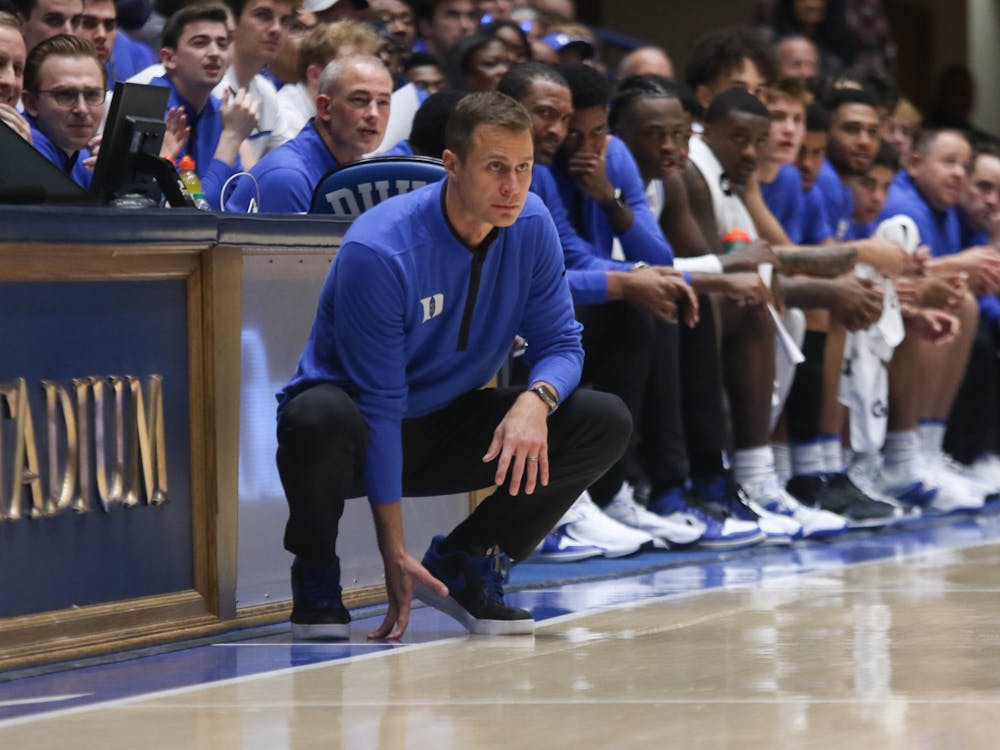Five contests in, it has been a mixed bag for the Blue Devils.
On paper, Duke has performed at roughly the level one would expect, considering its roster of 11 newcomers, a first-year head coach manning the bench in Jon Scheyer and injuries to freshman studs Dereck Lively II and Dariq Whitehead (who missed the opener and the first three games to start the year, respectively).
But there are still a few holes to poke in the Blue Devils’ 4-1 start. With that, let’s take a look under the hood to see how Duke has fared in two key areas heading into the marquee Phil Knight Legacy—offensive spacing and help defense.
Spacing, spacing, spacing
Now that Whitehead is back in the fold, Scheyer has his entire roster healthy. That means that the Blue Devils have a nine-man rotation, featuring four primary ball-handlers (Whitehead, Jeremy Roach, Jaylen Blakes and Tyrese Proctor), two slashers (Mark Mitchell and Jacob Grandison) and three versatile bigs (Lively, Kyle Filipowski and Ryan Young). For those skill sets to mesh on the offensive end, the Blue Devils’ spacing must be picture-perfect.
That might seem obvious, but throughout its 69-64 loss to No. 3 Kansas, poor spacing hurt Duke’s ability to break the Jayhawks down and cut off the ball. On the opening possession of the second half, for instance, Young had the ball on the right block after Proctor–coming off a high ball screen set by Filipowski (which switched Jalen Wilson onto Proctor and Gradey Dick onto Filipowski)–and Roach executed a dribble handoff, Roach swung to Mitchell and Mitchell dumped it down to Young.
Roach and Proctor switch places, with Roach moving to his original spot in the corner and Proctor at the top of the key. Gradey Dick, who switched back to Proctor when the ball was on the opposite side, is late to rotate out, which Young recognizes and kicks it to Proctor.
So far, the Blue Devils have executed well, moving themselves and the ball to give Proctor a chance to work here against a so-so defender in Dick. But Mitchell cuts middle right when Proctor receives the pass from Young, and Filipowski is planted in the short corner instead of out to the 3-point line. Proctor shot-fakes and drives left, but Wilson (guarding Filipowski) is in help, forcing Proctor to spin to his right and take a tough fall-away.
He hits it, but slightly better spacing would have resulted in either a layup for the Australian or an open Filipowski three from the corner.
Just look at how much better the Blue Devils’ spacing is on this first-half possession against Delaware. Roach and Blakes execute a dribble handoff before Blakes comes around a Young screen (while Grandison initially appears to be part of a double high with Young, but circles out to the right wing). Roach clears out to the opposite corner, emptying the right side of the floor for Grandison and Young, who dove after setting the screen for Blakes. Blakes swings to Grandison, who dumps to Young and cuts hard into the paint. Young, whose vision out of the post has been impressive so far, sets up the cutting Grandison for the dunk.
Spacing breeds quality looks, and while Whitehead, Proctor and Roach have the ability to create their own shots off the dribble, they won’t have to as much if the Blue Devils simply spread the court and move without the ball.
Where is the help?
Watch this clip.
You might think that Proctor is at fault for Dick getting a free alley at the rim, and yes, the freshman guard is overplaying the back screen set by Kansas' KJ Adams Jr. intended to free up Dick. But Lively, who is guarding Adams, is too slow to react here, and Mitchell (who is two passes away while guarding Kevin McCullar Jr. on the left block) should have two feet in the paint.
Neither is in proper help position, and Dick receives the lob from Dajuan Harris Jr.—who is able to get the pass off easily thanks to little ball pressure from Roach—and puts Kansas up 63-62 with just more than 90 seconds to play.
Earlier in the second half, the Blue Devils were again out of position in help side, as Wilson came around an Ernest Udeh Jr. screen, got his defender (Mitchell) on his back and proceeded to his right to attack the basket. Udeh, meanwhile, is sealing his defender (Lively), while Adams, who has not hit a triple in two career attempts, is on the left wing guarded by Filipowski.
Once Wilson drives right, Filipowski should slide in front of him to help Mitchell and Lively out, but instead, he hedges slightly but remains at the foul line. Roach, who is guarding Harris (who is two passes away in the opposite corner), should also sink down into the paint to help out on the Wilson drive.
Neither provides help, and Wilson gets an easy lay-in to tie the game at 41.
These assorted struggles with help defense could have spelled trouble for the Blue Devils against Bellarmine, as the Knights pass and cut all over the court. And yes, there were times during the 74-57 win when Bellarmine worked through nearly the entire shot clock and got a great look thanks to exquisite ball movement, but overall, the Blue Devils’ switching strategy paid off.
Trailing 7-6, Duke turned up the heat on the Knights, as Grandison pressured Peter Suder (No. 5) in the backcourt and seemingly switched with Blakes after Suder and Juston Betz executed a dribble handoff. When Suder and Alec Pfriem (No. 2) switch spots, Blakes and Roach switch as well, and Betz swings it to forward Langdon Hatton (No. 12, guarded by Young).
Meanwhile, Suder cuts baseline to the left wing as Garrett Tipton (No. 10) cuts baseline to the right, and Roach and Whitehead subsequently switch. Tipton and Pfriem switch spots, with Tipton now occupying the right wing, and Roach and Blakes switch again. Tipton swings it to Suder on the left wing, who tries to swing it to Pfriem after the latter has cut baseline again, this time going to the left corner.
But Roach is on Pfriem like glue, deflecting the pass and igniting a fast break that ends with a Whitehead slam.
With Lively at center, the Blue Devils could switch one through five, so against smaller lineups, look for Scheyer to employ heavy switching. How effective that will be against the likes of Oregon State, Florida, Xavier, Gonzaga, Purdue (likely opponents in Portland, Ore.,) or Ohio State or Iowa later in nonconference play remains to be seen, but Monday was a start.
Where does Duke go from here?
This week will be a major test. Oregon State, despite a respectable 3-1 record, sports a loss to Portland State (ranked 261st in the country by KenPom) and has good reason to be 18.5-point underdogs to a fully healthy Blue Devil group.
But if Duke gets by that matchup Thursday, it will face the winner of Florida-Xavier Friday. The Gators sit at 3-1 and recently engineered a 17-point second-half comeback against Florida State, while the Musketeers nearly knocked off No. 11 Indiana the same evening. Then, there is the possibility for a date with Drew Timme and No. 6 Gonzaga, Zach Edey and No. 24 Purdue or undefeated West Virginia in Sunday’s final.
Kansas was a clear indication that while the pieces are there for Duke to be a consistent top-10 team in Scheyer’s first season, it still has not fully clicked yet. But this week, the Blue Devils will get another chance to click on a huge stage.
To win the Phil Knight Legacy, they will need to.
Get The Chronicle straight to your inbox
Signup for our weekly newsletter. Cancel at any time.

Max Rego is a Trinity senior and an associate sports editor for The Chronicle's 118th volume. He was previously sports managing editor for Volume 117.

